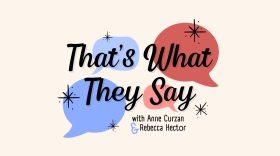This week, our listener Nancy Magnani got us thinking about the word "mug". Why it can refer to everything from a face or silly expression, to an attack or a robbery.
Of course, let's not forget the mugs that we use to drink our morning coffee. As it turns out, there's a relationship between the "mug" that refers to a drinking vessel and the "mug" that refers to a face.
In the 1700s, some drinking mugs were made with caricatured faces on them. That’s likely how "mug" became slang for a face, especially an unattractive one. For example, someone might say something like, "He better not show his ugly mug in here."
In the early 1800s, "mug" also came to describe exaggerated or silly facial expressions. For instance, someone might make mugs in a mirror to amuse themself. This usage evolved into the verb "to mug," as in "mugging for the camera."
By the late 1800s, a photograph of someone’s face, especially a criminal’s, could be referred to as a "mugshot." Collections of these photos were put together in "mug books" that police could then use to help identify suspects.
Separately, "mug" was also part of boxing slang in the early 1800s, meaning to strike someone in the face. By the mid-1800s, "to mug" had taken on the more general criminal meaning of "to attack or rob."
To hear about more uses of "mug," listen to the audio above.






